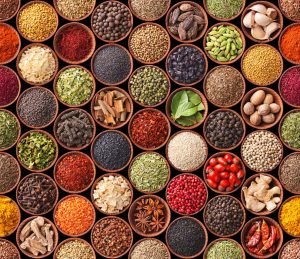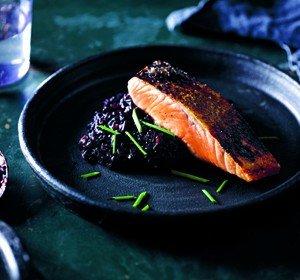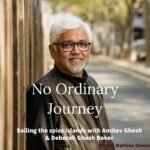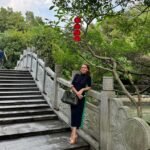I am besotted with Banda Neira; with its breathtaking beauty, chequered history and its sense that the past and present seem to mysteriously co-exist. In this forgotten wilderness, the course of history changed forever, simply because of nutmeg, and the hunt for this seductive spice helped shape the face of modern commerce.
Banda Neira lies in the middle of ten small, sun-drenched volcanic islands loosely scattered in the wind-swept Banda Seas, south-east of Ambon. Often omitted from maps, the tranquil port was once an important harbour and the town itself, a centre of trade and V.O.C base.
For more than 3,000 years, regional, Arab and Chinese merchants exchanged spices and other treasures with the Bandanese but the main attraction was the glamorous nutmeg. Before the birth of Christ, it had already reached China and India and by 500AD it had arrived in the Mediterranean. Even Sinbad the Sailor from the Arabian Nights was lured by its charm.

By the 14th-century, it was gracing the table of European aristocracy and by 15thcentury Germany, a pound was worth “seven fat oxen”. It dazzled the Venetians, courtesy of Arabian traders, who sold it as spice, scent, aphrodisiac and medicine for highly inflated prices. Europeans, desperate to seek its secret location, entered the race after the 1500’s fueled with a crazed determination to conquer the market.
The Dutch eventually conquered the archipelago, started their expansion of Indonesia from the 1600’s and until the 19th Century, the Banda islands remained the world centre of trade for nutmeg and mace.
Arrive in Banda Neira
The best way to arrive in Banda Neira is by sea, preferably at dawn, following the ancient spice trade route. After sailing from Ambon through an unimaginable silence on deep, glossy waters, you enter a picture-perfect harbour in the shadow of the lofty volcano, Gunung Api. Surrounded by densely wooded mountains, a watercolour haze of inky-blue light and silvery layers of mist unfolds as you glide into the quiet township. The history of the fabled Spice Islands, the Treaty of Breda and the consequent exchange of nearby Rhun Island for Manhattan, then a Dutch fur trading post, fuels the intrigue. To arrive on a teak phinisi-style boat, an Indonesian pirate ship, makes it nothing short of magical, a journey like no other.
It is hard to fathom the onetime hysteria for nutmeg. There is no doubt it holds a deeply alluring, captivating scent that is only matched by its startling natural packaging. Apart from its culinary prowess and preserving powers, it was popular as an aphrodisiac which always makes for a best seller. But its crowning glory, in Elizabethan times, was its supposed curative properties to ward off the Plague, the Black Death. A small slice of nutmeg worn around the neck was the coveted talisman to offer protection. Who knows if it actually worked?
Nutmeg
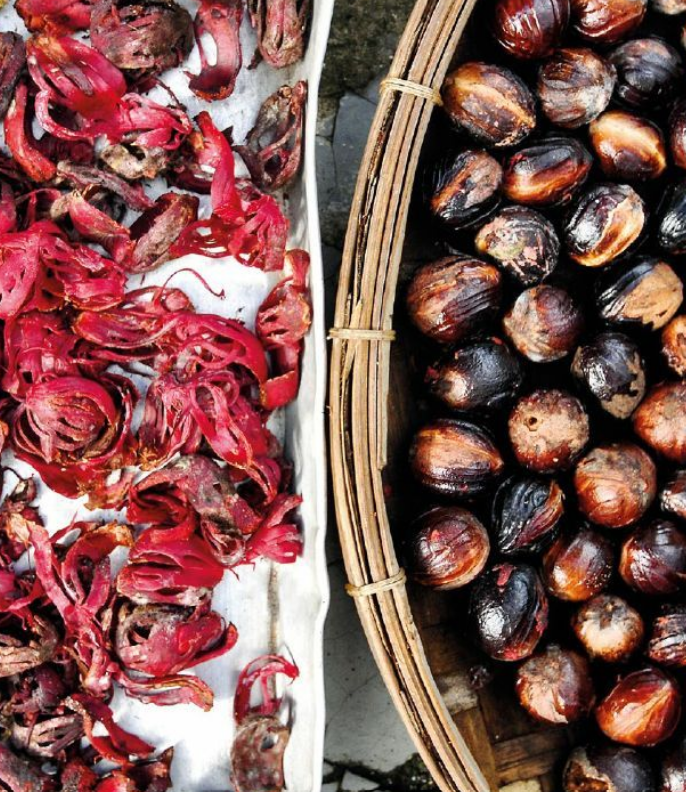
Nutmeg is the kernel of the fruit, the beautifully named myristica fragrens, that grows on the large evergreen nutmeg tree. Roughly the size of an apricot, it has a firm, moist, woody texture and gingery flavour. The glossy, lacquer-red, web of mace, the aril, is wrapped so tightly around the shell that it leaves an indentation, a natural print, when removed. On Banda Besar I was shown nutmeg with a white aril and was told there are up to five other types of nutmeg in this area. On the pint-sized island of Rhun I saw a tree of 300 years and many others of at least one hundred. Traditionally, they are planted in the shade of enormous leafy kenari trees, the ubiquitous native almond of the Malukus, and in one season they can yield up to 20,000 nutmegs.
So what about nutmeg in Indonesian food?
In Banda Neira, I ate delicate fish soup, scented with lemongrass, lemon basil and thin slices of nutmeg fruit. In Javanese beef dishes, such as rawon, ground nutmeg lies in the darkened broth. It appears in soups and curries across the archipelago, some folk use it in rendang, Sumatra’s award-winning dry beef curry, and in Bali, a sliver is present in Base Wangen, a traditional mix of fragrant seeds and nuts.
The dried fruit is sold across the archipelago and nutmeg balsam is a favourite for warming up the body and alleviating congestion. My favourite Dutch-style Speculaas biscuits are flavoured with nutmeg alongside cloves and cinnamon.
In large doses, due to the presence of myristicin, nutmeg is basically a poisonous narcotic. In small quantities, it is said to relieve pain, stimulate digestion, strengthen cognitive function, boost skin and gum health, as well as, the immune system. But perhaps its greatest attribute is to stimulate serotonin which creates a feeling of sedation. A glass of warm milk with grated nutmeg will have you snoring like a grandpa.
A contrary conclusion to an aphrodisiac!
There’s something about being in a place that’s played a major yet bloodied part in history; it is hard not to be both intrigued and saddened. I visited the pint-sized island of Rhun and climbed the hill to see the abandoned stone cottage of Nathaniel Courthope, the British soldier who defended the island against the Dutch for 4 years. A giant portrait of the late Des Alwi, the unofficial king of Banda Neira and man of letters who protected Christians in the religious conflict in the late 90’s, is painted on the school wall in the village. That this desolate outpost once created ongoing battles between the Dutch and British is unfathomable.
I spent a morning on the nearby island of Banda Besar. Pongky Van Den Broeke was our guide and walked us through his nutmeg plantation chatting about colonial history, Indonesian independence and the cultivation of the coveted spice. For thirteen generations his family nurtured the business and he still practices their age-old techniques.
He sliced open nutmeg fruits, revealing the dazzling web of red mace and showed how it is stored and dried. His recounting of the murder of his mother, aunt, wife and two daughters during the conflict left us speechless and teary-eyed. Coffee and nutmeg biscuits were served by a new wife, while his two young daughters watched on, shyly.
For gastronomic gifts, Pongky Van Den Broeke and other locals in Banda Neira, sell nutmeg jam, nutmeg cookies, nutmeg syrup, preserved fruit and other spice-infused treats. Eighty per cent of the world’s nutmeg still comes from Indonesia and it is mainly used for confectionary, drinks, spice mixes, perfume and pharmaceutical products. It is said to be a secret ingredient in Coca Cola.
Considered one of the last unspoiled natural environments, the unique marine life and coral reefs of Banda Neira provide some of the best snorkeling and diving on the planet. It’s a piscine island paradise, there’s no doubt about it. Jacques Cousteau spent time here, as did, Ron and Valerie Taylor, Mick Jagger, Princess Diana and Bill Bailey. Some say, if it were not for nutmeg, the world would not even know about this exotic settlement. In the meantime, Banda Neira is slowly re-awakening and getting ready to enter a new underwater global race. Watch this space!
This article was first published in Garuda’s Inflight Magazine Colors Edition April 2018


